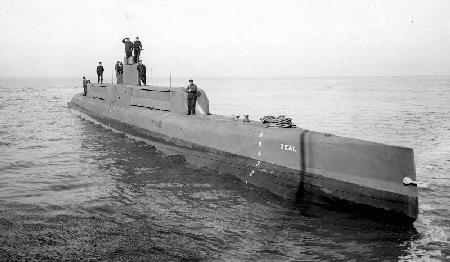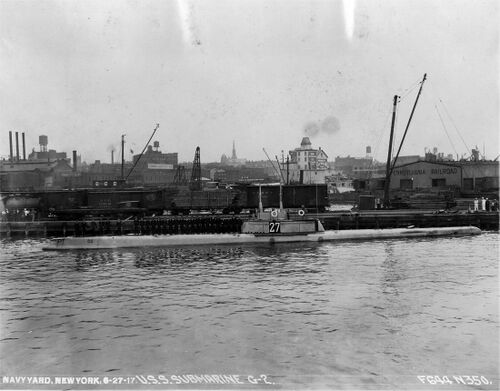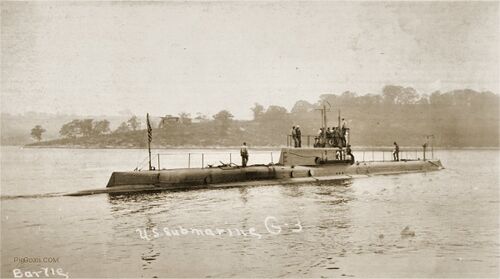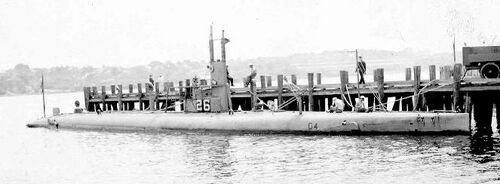G-class: Difference between revisions
Pbcjohnston (talk | contribs) Formatting fix |
Pbcjohnston (talk | contribs) mNo edit summary |
||
| Line 10: | Line 10: | ||
</div> | </div> | ||
===<big>G-1 (Submarine No. 19½, later SS-20)</big>=== | ===<big>Seal/G-1 (Submarine No. 19½, later SS-20)</big>=== | ||
[[File:Seal 1.jpg|left|500px|Submarine Seal, February 8, 1911.]] | [[File:Seal 1.jpg|left|500px|Submarine Seal, February 8, 1911.]] | ||
<div style="text-align: justify;"><span style="color:#00008B">Simon Lake's submarine Seal is shown here shortly after her launch from Newport News Shipbuilding, Virginia on February 8, 1911. It would be nearly another two years before she was commissioned into the United States Navy, and then only reluctantly. During this fitting out period her name was changed to G-1.</span><br><br> | <div style="text-align: justify;"><span style="color:#00008B">Simon Lake's submarine Seal is shown here shortly after her launch from Newport News Shipbuilding, Virginia on February 8, 1911. It would be nearly another two years before she was commissioned into the United States Navy, and then only reluctantly. During this fitting out period her name was changed to G-1.</span><br><br> | ||
| Line 19: | Line 19: | ||
[[File:Red bar sub.jpg]] | [[File:Red bar sub.jpg]] | ||
===<big>G-2 (Submarine No. 27)</big>=== | ===<big>Tuna/G-2 (Submarine No. 27)</big>=== | ||
[[File:G2-g2bny1-01.jpg|left|500px|Photo courtesy of the National Archives]] | [[File:G2-g2bny1-01.jpg|left|500px|Photo courtesy of the National Archives]] | ||
| Line 28: | Line 28: | ||
[[File:Red bar sub.jpg]] | [[File:Red bar sub.jpg]] | ||
===<big>G-3 (Submarine No. 31)</big>=== | ===<big>Turbot/G-3 (Submarine No. 31)</big>=== | ||
[[File:G3-g3wcrew-03.jpg|left|500px|Photo in the private collection of Ric Hedman.]] | [[File:G3-g3wcrew-03.jpg|left|500px|Photo in the private collection of Ric Hedman.]] | ||
<div style="text-align: justify;"><span style="color:#00008B">The G-3 at an unknown location but possibly on the Thames River, Connecticut, summer 1916. The submarine is proceeding at a very slow pace on the battery with her engines shut down. The battery was used on these early subs when maneuvering near a pier. The direct drive diesels were incapable of being reversed, so if a backing bell was needed the electric motors had to be used. On the far left at the tip of the superstructure are two doors that open to port and starboard, revealing two aft firing 18" torpedo tubes. These were single shot tubes and could only be reloaded in-port. | <div style="text-align: justify;"><span style="color:#00008B">The G-3 at an unknown location but possibly on the Thames River, Connecticut, summer 1916. The submarine is proceeding at a very slow pace on the battery with her engines shut down. The battery was used on these early subs when maneuvering near a pier. The direct drive diesels were incapable of being reversed, so if a backing bell was needed the electric motors had to be used. On the far left at the tip of the superstructure are two doors that open to port and starboard, revealing two aft firing 18" torpedo tubes. These were single shot tubes and could only be reloaded in-port. | ||
| Line 38: | Line 38: | ||
[[File:Red bar sub.jpg]] | [[File:Red bar sub.jpg]] | ||
===<big>G-4 (Submarine No. 26, later SS-26)</big>=== | ===<big>Thrasher/G-4 (Submarine No. 26, later SS-26)</big>=== | ||
[[File:G4-4g44-16.jpg|left|500px|U.S. Navy photo]] | [[File:G4-4g44-16.jpg|left|500px|U.S. Navy photo]] | ||
<div style="text-align: justify;"><span style="color:#00008B">G-4 moored at Submarine Base New London, CT., 1915-16. This photo shows her with a modification to her periscope shears, with bracing and metal plating added in an attempt to keep them from vibrating while running submerged. The Laurenti design awkwardly placed these fixed height periscopes forward of the conning tower. On the far left, the boat's topside rudder can be seen.</span></div> | <div style="text-align: justify;"><span style="color:#00008B">G-4 moored at Submarine Base New London, CT., 1915-16. This photo shows her with a modification to her periscope shears, with bracing and metal plating added in an attempt to keep them from vibrating while running submerged. The Laurenti design awkwardly placed these fixed height periscopes forward of the conning tower. On the far left, the boat's topside rudder can be seen.</span></div> | ||
Revision as of 00:27, 6 September 2024

Design, Construction, and Naming Notes
G-1 represents a unique anomaly in the USN. Her development and construction was so troubled that the Navy was very unsure if they would even accept it. When it did eventually pass acceptance trials, the Navy awkwardly assigned it hull number 19½, the only time in its entire history that the Navy assigned half a hull number to a commissioned warship. When the USS F-1 (Submarine No. 20) was lost in a collision, the Navy took another unprecedented step and reassigned the F-1's hull number to G-1. She was eventually redesignated in the SS series, but not long after she was disposed of as a depth charge target.
Seal/G-1 (Submarine No. 19½, later SS-20)

Tuna/G-2 (Submarine No. 27)

Turbot/G-3 (Submarine No. 31)

Thrasher/G-4 (Submarine No. 26, later SS-26)

Page created by:
Ric Hedman & David Johnston
1999 - 2023 - PigBoats.COM©
Mountlake Terrace, WA, Norfolk, VA
webmaster at pigboats dot com